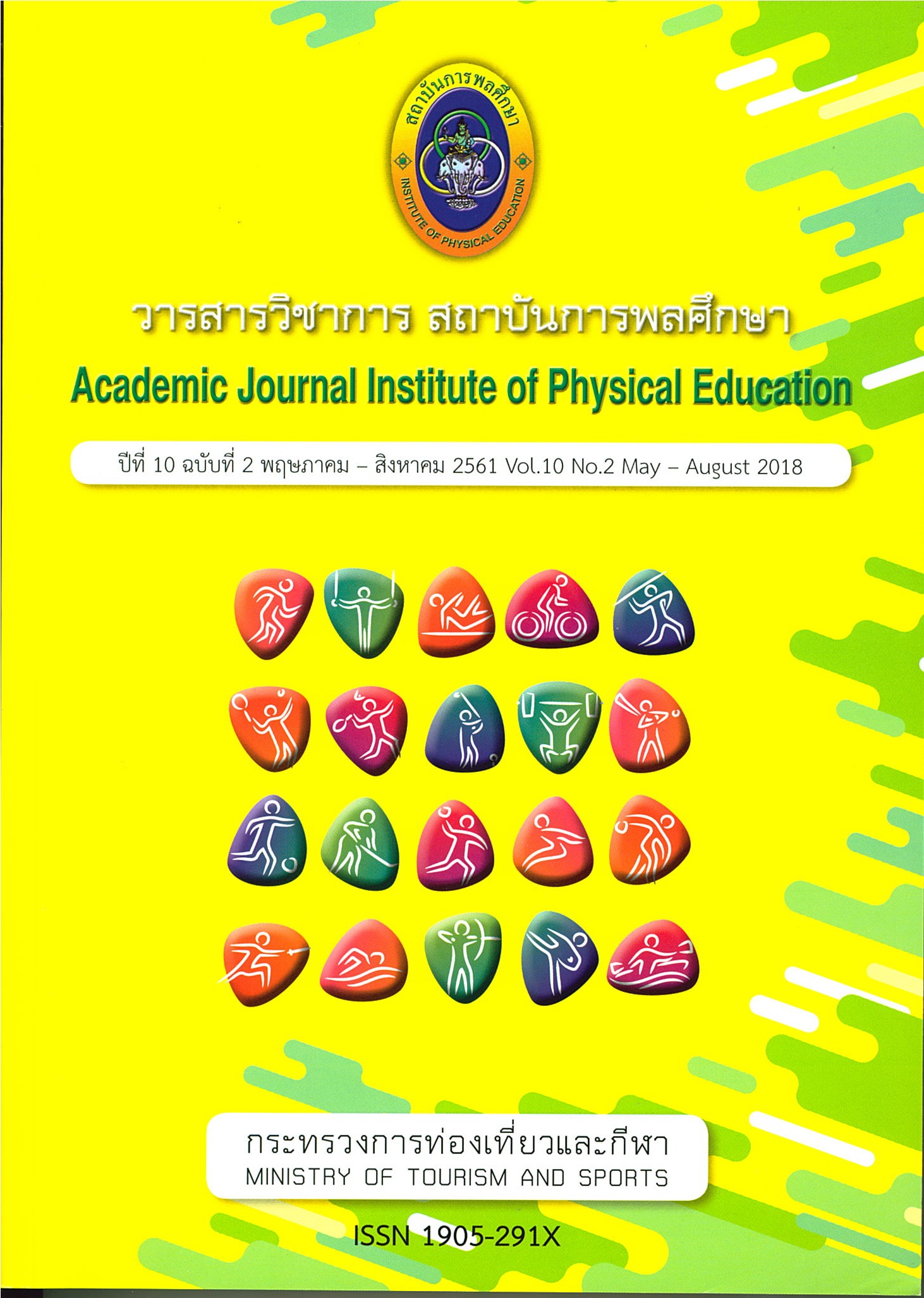The Development Model of Women’s Football of Thailand
Main Article Content
Abstract
The purposes of this study were : (1) to examine problems and obstacles relating to the developmentof women’s football inThailand, and (2) tocreatea development model of women’s football in Thailand. This mixed-method research consisted of four stages by using samples or primary informants to collect data. (1) Theories and related research studies were reviewed, five key informants in the field were in-depth interviewed to determine the research framework. The 30 stakeholders, derived from purposive sampling method, were interviewed to explore problems and obstacles in the development of women’s football inThailand. (2) A development model of women football was constructed and tried out by 21 football players through purposive sampling and by Dephi technique. (3) The development model was then investigated by a focus group discussion with 16 experts for its validity and feasibility. Finally, recommendations were applied to adjust the modelof women’s football in Thailand. The research instruments included interviews, an open-ended questionnaire, a rating scale questionnaire, and a group discussion. Data were analyzed by percentages, frequency, median, and the inter-quartile ranges.
The research findings indicated that: (1) the primary problems and obstacles in the development of women’s football in Thailand were the lacking of developing plans for women’s football athletes, coaches, referees, continuous personnel improvement, sport science development, learning resources, and sufficient related mediaon women’s football. Moreover,national sport contest were not conformed to international standard. Its marketing and public relations also were not supported by any national agencies. This woman sport has were hardly accepted by families and society in Thailand. (2)The finding also suggested that the development model of women’s football in Thailand must comprise of a training and education developmentcenter for players, coaches, referees,and sports personnel with theaim to improve techniques, sport sciences, and competitions in particular.The national sport contest should be inconformity with international standardized requirements and publically supported to build potential best practice players. In addition, public relations, marketing activities, and communication should also be promoted for social awareness of women’s football. In conclusion, there still have been several insufficient developments in many main elements of women’s football. They should be given consideration and
be improved by establishing a learning and development center to develop the potential of women’s football into the international level and by building family and social acceptance both nationally and internationally
Article Details
The published article is a copyright of the Academic Journal of Thailand National Sports University. The passage appeared in each article in this academic journal is a perspective of each author which is not related to the journal. Each author is required to be responsible for all components of his/her own article. If there are any mistakes, each author must be responsible for those mistakes on his/her own.
References
ถนอมวงศ์ กฤษณ์เพ็ชร์, รัชนี ขวัญบุญจัน, ศิลปชัย สุวรรณธาดา, สมชาย ประเสิรฐศิริพันธ์, สุวัตร สิทธิหล่อ, ชัยพัฒน์ หล่อศิริรัตน์, บุญศักดิ์ หล่อพิพัฒน์, และชัยสิทธิ์ ภาวิลาส. (2552).การศึกษาปัจจัยความสำเร็จของชนิดกีฬาที่เป็นความหวังของประเทศไทย.กรุงเทพฯ: สำนักวิชาวิทยาศาสตร์การกีฬาจุฬาลงกรณ์มหาวิทยาลัย (ทุนการวิจัยการกีฬาแห่งประเทศไทย), 40-41.
รัชนี ขวัญบุญจัน. (2552). ปัจจัยความสำเร็จ (Key success Factors) ของกีฬาฟุตบอล.งานวิจัยการกีฬาแห่งประเทศไทย กระทรวงท่องเที่ยวและกีฬา.
Asian Football Confederation. (2007). Vision Asia. Slide.
Federation International Football Association. (2008). Developing Football for Girls and Women: Best practices, case studies and key findings from all over the world. Altstatten: rva Druck and Media, 56-59.
Federation International Football Association. (2012). Women’s Football Developing the Games. Altstatten: rva Druck and Media, 21-43.
Ullrich, H. (2008).“Providing coaching education programmes to encourage the development and sustained participation of players from the German women’s national team: A Case Study of Germany”. Developing Football for Girls and Women : Best practices, case studies and key findings from all over the world. 106-111.
Pawel, H. (20 March 2015). FIFA Woman Instructor. interview.
Cox, M. (2008). “Developing girls’ football through the “Small Whites” grassroots programme: A Case Study of New Zealand”. Developing Football for Girls and Women: Best practices, case studies and key findings from all over the world. 66-71.
Akers, V. (2008).“Promoting and raising awareness of women’s football in a high-profile men’s club. How can men’s football help? : A Case Study of England (Arsenal)”. Developing Football for Girls and Women: Best practices, case studies and key findings from all over the world. 155-156.


